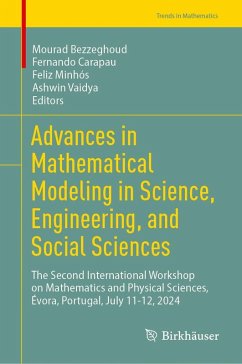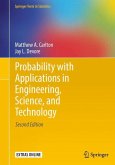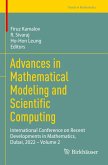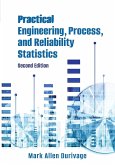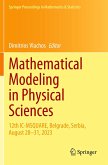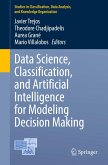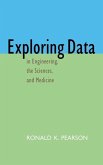Advances in Mathematical Modeling in Science, Engineering, and Social Sciences
The Second International Workshop on Mathematics and Physical Sciences, Évora, Portugal, July 11-12, 2024
Herausgegeben:Bezzeghoud, Mourad; Carapau, Fernando; Minhós, Feliz; Vaidya, Ashwin
Advances in Mathematical Modeling in Science, Engineering, and Social Sciences
The Second International Workshop on Mathematics and Physical Sciences, Évora, Portugal, July 11-12, 2024
Herausgegeben:Bezzeghoud, Mourad; Carapau, Fernando; Minhós, Feliz; Vaidya, Ashwin
- Gebundenes Buch
- Merkliste
- Auf die Merkliste
- Bewerten Bewerten
- Teilen
- Produkt teilen
- Produkterinnerung
- Produkterinnerung
This volume collects chapters based on talks given at "The Second International Workshop on Mathematics and Physical Sciences," held in July 2024 at the University of Évora, Portugal, which is a conference of the 9th European Congress of Mathematics of the European Mathematical Society. Chapters bring together well-known experts in a variety of areas to discuss recent trends and challenges in mathematics, physics, and the social sciences, and to encourage new collaborations. A wide range of topics are covered, including: Evolutionary dynamics of cellular automataFluid modeling of blood…mehr
Andere Kunden interessierten sich auch für
![Probability with Applications in Engineering, Science, and Technology Probability with Applications in Engineering, Science, and Technology]() Matthew A. CarltonProbability with Applications in Engineering, Science, and Technology122,99 €
Matthew A. CarltonProbability with Applications in Engineering, Science, and Technology122,99 €![Advances in Mathematical Modeling and Scientific Computing Advances in Mathematical Modeling and Scientific Computing]() Advances in Mathematical Modeling and Scientific Computing175,99 €
Advances in Mathematical Modeling and Scientific Computing175,99 €![Practical Engineering, Process, and Reliability Statistics Practical Engineering, Process, and Reliability Statistics]() Mark Allen DurivagePractical Engineering, Process, and Reliability Statistics59,99 €
Mark Allen DurivagePractical Engineering, Process, and Reliability Statistics59,99 €![Mathematical Modeling in Physical Sciences Mathematical Modeling in Physical Sciences]() Mathematical Modeling in Physical Sciences175,99 €
Mathematical Modeling in Physical Sciences175,99 €![Data Science, Classification, and Artificial Intelligence for Modeling Decision Making Data Science, Classification, and Artificial Intelligence for Modeling Decision Making]() Data Science, Classification, and Artificial Intelligence for Modeling Decision Making113,99 €
Data Science, Classification, and Artificial Intelligence for Modeling Decision Making113,99 €![Critical Thinking and Creative Analogies in Statistics, Science, and Technology Critical Thinking and Creative Analogies in Statistics, Science, and Technology]() Mark ChangCritical Thinking and Creative Analogies in Statistics, Science, and Technology208,99 €
Mark ChangCritical Thinking and Creative Analogies in Statistics, Science, and Technology208,99 €![Exploring Data in Engineering, the Sciences, and Medicine Exploring Data in Engineering, the Sciences, and Medicine]() Ronald K. PearsonExploring Data in Engineering, the Sciences, and Medicine184,99 €
Ronald K. PearsonExploring Data in Engineering, the Sciences, and Medicine184,99 €-
-
-
This volume collects chapters based on talks given at "The Second International Workshop on Mathematics and Physical Sciences," held in July 2024 at the University of Évora, Portugal, which is a conference of the 9th European Congress of Mathematics of the European Mathematical Society. Chapters bring together well-known experts in a variety of areas to discuss recent trends and challenges in mathematics, physics, and the social sciences, and to encourage new collaborations. A wide range of topics are covered, including:
Evolutionary dynamics of cellular automataFluid modeling of blood flowInverse conductivity problemsPassive remote sensing from spaceNetwork theoretic modeling of soccer
Advances in Mathematical Modeling in Science, Engineering, and Social Sciences will be a valuable resource for researchers in mathematics and the physical sciences with a broad research interest.
Evolutionary dynamics of cellular automataFluid modeling of blood flowInverse conductivity problemsPassive remote sensing from spaceNetwork theoretic modeling of soccer
Advances in Mathematical Modeling in Science, Engineering, and Social Sciences will be a valuable resource for researchers in mathematics and the physical sciences with a broad research interest.
Produktdetails
- Produktdetails
- Trends in Mathematics
- Verlag: Springer, Berlin; Birkhäuser
- Artikelnr. des Verlages: 89511395
- Seitenzahl: 480
- Erscheinungstermin: 26. Januar 2026
- Englisch
- Abmessung: 235mm x 155mm
- ISBN-13: 9783032102805
- ISBN-10: 3032102804
- Artikelnr.: 75529443
- Herstellerkennzeichnung
- Springer-Verlag GmbH
- Tiergartenstr. 17
- 69121 Heidelberg
- ProductSafety@springernature.com
- Trends in Mathematics
- Verlag: Springer, Berlin; Birkhäuser
- Artikelnr. des Verlages: 89511395
- Seitenzahl: 480
- Erscheinungstermin: 26. Januar 2026
- Englisch
- Abmessung: 235mm x 155mm
- ISBN-13: 9783032102805
- ISBN-10: 3032102804
- Artikelnr.: 75529443
- Herstellerkennzeichnung
- Springer-Verlag GmbH
- Tiergartenstr. 17
- 69121 Heidelberg
- ProductSafety@springernature.com
Dr. Mourad Bezzeghoud is a distinguished geophysicist and Full Professor at the University of Évora, Portugal. Born in Oran, Algeria, he earned his engineering degree in Applied Geophysics from INHC Boumerdes, followed by a Master’s and PhD in Geophysics from the University Denis Diderot – Paris VII. His research focuses on earthquake seismology, seismic risk, and seismotectonics, particularly in the Ibero-Maghrebian region. Dr. Bezzeghoud has held academic positions across Europe and North Africa, including at the École des Mines de Paris and the University Complutense of Madrid. He has published extensively and coordinated numerous national and international conferences. At Évora, he has served as Director of the School of Science and Technology, President of the Physics Department, and Coordinator of the Institute of Earth Sciences. He is currently an integrated member of the Center for Sci-Tech Research in Earth System and Energy (CREATE), University of Évora (Portugal). Fernando Carapau is an Associate Professor at the University of Évora in Portugal and Director of the School of Science and Technology. He holds a PhD and Habilitation in Mathematics from Instituto Superior Técnico, University of Lisbon, and a Bachelor's degree in Mathematical Analysis from the University of Évora. His research focuses on mathematical analysis and numerical methods for ordinary and partial differential equations, with applications in fluid mechanics and hemodynamics. Dr. Carapau is an integrated member of the Research Centre for Mathematics and Applications (CIMA) and collaborates with CEMAT-IST. He has developed one-dimensional models using Cosserat theory to study fluid flow in straight and curved tubes, contributing to the understanding of complex fluid-structure interactions. His publications span international journals, highlighting his expertise in non-Newtonian fluid dynamics and applied mathematics. Dr. Feliz Manuel Barrão Minhós is a Full Professor in the Department of Mathematics at the University of Évora, Portugal. He holds a PhD and Habilitation in Mathematics and serves as Director of the PhD Program in Mathematics and the Research Centre for Mathematics and Applications (CIMA). His research spans differential equations, boundary value problems, fixed point theory, impulsive systems, and functional differential equations, with a focus on variational and topological methods. Dr. Minhós has published extensively in international journals, books, and conference proceedings, contributing significantly to nonlinear analysis and mathematical modeling. He is a member of the editorial boards of several scholarly journals and actively collaborates with researchers worldwide. In addition to his academic roles, he serves on the Scientific Council of the School of Science and Technology and the editorial board of Évora University Press, reflecting his leadership in both research and institutional development. Dr. Ashwin Vaidya is a Full Professor in the Department of Mathematics at Montclair State University in Montclair, New Jersey. He holds a Ph.D. in Mechanical Engineering and multiple degrees in Physics and Mathematics from the University of Pittsburgh. Dr. Vaidya’s interdisciplinary research focuses on complex systems, fluid dynamics, and mathematical modeling of biological, psychological, and sociological phenomena. He also holds a joint appointment in the Department of Physics and Astronomy. His academic journey includes postdoctoral appointments at Carnegie Mellon University, Florida State University, and the University of North Carolina at Chapel Hill. Dr. Vaidya is deeply committed to socially responsible education and has contributed to curriculum development that integrates civic and ethical perspectives. He is the Director of the Complex Fluids Laboratory and has also served as Chairperson of the Mathematics Department and Director of the Science Honors Innovation Program at Montclair State University.
Part I Pure Mathematics.
Chapter 1 Algebraic structure for recombining cellular automata.
Chapter 2 Extending Meadows to the Non
Comutative Case.
Chapter 3 Determinant
Permanent Relations in Singular Symmetric Matrices.
Chapter 4 A note on nonlocal supremal functionals.
Chapter 5 Ambrosetti
Prodi alternative for higher
order functional problems.
Chapter 6 Factorisation of the Classical Nonstandard Bounded Functional Interpretation.
Chapter 7 Elementary nonstandard axiomatic systems and standard real numbers.
Part II Differential Equations & Dynamical Systems.
Chapter 8 SBH
ellipticity of the relaxed interfacial energy density in the context of second
order structured deformations.
Chapter 9 First
Order Nonlinear Problems with Re ection and Piecewise Constant Dependence.
Chapter 10 Milnor Attractors on pattern iterations of flat
topped tent maps revisited.
Chapter 11 Vasicek and CIR stochastic differential equations models applied to mortality rates.
Part III Applied Mathematics & Mathematical Modeling.
Chapter 12 Mathematical modelling of global solar radiation using machine learning.
Chapter 13 Modelling and Characterization of Photovoltaic Thermal System an Overview.
Chapter 14 Investigation of Virus Transmission in Plants by Using Time Delay Tool, Curative and Preventive Treatment.
Chapter 15 Passive Seismic Tomography: Evaluating the Effect of Earthquake Clustering on Crustal Structure Accuracy.
Chapter 16 Simulation and Statistical Analysis of Streamer Discharges in Spherical Cavities under HVDC Conditions.
Chapter 17 Mathematical Modeling of Collective Behavior in Physical and Social Systems.
Chapter 18 Analysis and Mathematical Recomposition of The Art of the Fugue.
Part IV Machine Learning & Data Science Applications.
Chapter 19 A Normalized Deep Learning Framework for 2D Linear Elasticity with Graph Neural Networks.
Chapter 20 Portuguese Archives Handwritten Text Recognition of Passport Requisitions.
Part V Statistics & Estimation Theory.
Chapter 21 Delta method estimation for SDE mixed models: sensitivity to random parameter distribution.
Chapter 22 Modeling Air Quality During Portugal's Fire Season Using Extreme Value Theory.
Chapter 23 Novel and Robust Total Least Squares Estimation Method for Non Linear Models.
Chapter 24 Four Estimation Approaches for Structural Equation Modeling: an Empirical Appli
cation in psychosocial risk.
Chapter 25 Statistical information theory and its importance for the development of statistical methods.
Part VI Optimization & Control in Stochastic Environments.
Chapter 26 Optimal harvesting in randomly varying environments: sensitivity of profit and effort to population and economic parameter.
Chapter 27 State Space Interpretation of Governance: A Control Theoretic Perspective.
Chapter 1 Algebraic structure for recombining cellular automata.
Chapter 2 Extending Meadows to the Non
Comutative Case.
Chapter 3 Determinant
Permanent Relations in Singular Symmetric Matrices.
Chapter 4 A note on nonlocal supremal functionals.
Chapter 5 Ambrosetti
Prodi alternative for higher
order functional problems.
Chapter 6 Factorisation of the Classical Nonstandard Bounded Functional Interpretation.
Chapter 7 Elementary nonstandard axiomatic systems and standard real numbers.
Part II Differential Equations & Dynamical Systems.
Chapter 8 SBH
ellipticity of the relaxed interfacial energy density in the context of second
order structured deformations.
Chapter 9 First
Order Nonlinear Problems with Re ection and Piecewise Constant Dependence.
Chapter 10 Milnor Attractors on pattern iterations of flat
topped tent maps revisited.
Chapter 11 Vasicek and CIR stochastic differential equations models applied to mortality rates.
Part III Applied Mathematics & Mathematical Modeling.
Chapter 12 Mathematical modelling of global solar radiation using machine learning.
Chapter 13 Modelling and Characterization of Photovoltaic Thermal System an Overview.
Chapter 14 Investigation of Virus Transmission in Plants by Using Time Delay Tool, Curative and Preventive Treatment.
Chapter 15 Passive Seismic Tomography: Evaluating the Effect of Earthquake Clustering on Crustal Structure Accuracy.
Chapter 16 Simulation and Statistical Analysis of Streamer Discharges in Spherical Cavities under HVDC Conditions.
Chapter 17 Mathematical Modeling of Collective Behavior in Physical and Social Systems.
Chapter 18 Analysis and Mathematical Recomposition of The Art of the Fugue.
Part IV Machine Learning & Data Science Applications.
Chapter 19 A Normalized Deep Learning Framework for 2D Linear Elasticity with Graph Neural Networks.
Chapter 20 Portuguese Archives Handwritten Text Recognition of Passport Requisitions.
Part V Statistics & Estimation Theory.
Chapter 21 Delta method estimation for SDE mixed models: sensitivity to random parameter distribution.
Chapter 22 Modeling Air Quality During Portugal's Fire Season Using Extreme Value Theory.
Chapter 23 Novel and Robust Total Least Squares Estimation Method for Non Linear Models.
Chapter 24 Four Estimation Approaches for Structural Equation Modeling: an Empirical Appli
cation in psychosocial risk.
Chapter 25 Statistical information theory and its importance for the development of statistical methods.
Part VI Optimization & Control in Stochastic Environments.
Chapter 26 Optimal harvesting in randomly varying environments: sensitivity of profit and effort to population and economic parameter.
Chapter 27 State Space Interpretation of Governance: A Control Theoretic Perspective.
Part I Pure Mathematics.
Chapter 1 Algebraic structure for recombining cellular automata.
Chapter 2 Extending Meadows to the Non
Comutative Case.
Chapter 3 Determinant
Permanent Relations in Singular Symmetric Matrices.
Chapter 4 A note on nonlocal supremal functionals.
Chapter 5 Ambrosetti
Prodi alternative for higher
order functional problems.
Chapter 6 Factorisation of the Classical Nonstandard Bounded Functional Interpretation.
Chapter 7 Elementary nonstandard axiomatic systems and standard real numbers.
Part II Differential Equations & Dynamical Systems.
Chapter 8 SBH
ellipticity of the relaxed interfacial energy density in the context of second
order structured deformations.
Chapter 9 First
Order Nonlinear Problems with Re ection and Piecewise Constant Dependence.
Chapter 10 Milnor Attractors on pattern iterations of flat
topped tent maps revisited.
Chapter 11 Vasicek and CIR stochastic differential equations models applied to mortality rates.
Part III Applied Mathematics & Mathematical Modeling.
Chapter 12 Mathematical modelling of global solar radiation using machine learning.
Chapter 13 Modelling and Characterization of Photovoltaic Thermal System an Overview.
Chapter 14 Investigation of Virus Transmission in Plants by Using Time Delay Tool, Curative and Preventive Treatment.
Chapter 15 Passive Seismic Tomography: Evaluating the Effect of Earthquake Clustering on Crustal Structure Accuracy.
Chapter 16 Simulation and Statistical Analysis of Streamer Discharges in Spherical Cavities under HVDC Conditions.
Chapter 17 Mathematical Modeling of Collective Behavior in Physical and Social Systems.
Chapter 18 Analysis and Mathematical Recomposition of The Art of the Fugue.
Part IV Machine Learning & Data Science Applications.
Chapter 19 A Normalized Deep Learning Framework for 2D Linear Elasticity with Graph Neural Networks.
Chapter 20 Portuguese Archives Handwritten Text Recognition of Passport Requisitions.
Part V Statistics & Estimation Theory.
Chapter 21 Delta method estimation for SDE mixed models: sensitivity to random parameter distribution.
Chapter 22 Modeling Air Quality During Portugal's Fire Season Using Extreme Value Theory.
Chapter 23 Novel and Robust Total Least Squares Estimation Method for Non Linear Models.
Chapter 24 Four Estimation Approaches for Structural Equation Modeling: an Empirical Appli
cation in psychosocial risk.
Chapter 25 Statistical information theory and its importance for the development of statistical methods.
Part VI Optimization & Control in Stochastic Environments.
Chapter 26 Optimal harvesting in randomly varying environments: sensitivity of profit and effort to population and economic parameter.
Chapter 27 State Space Interpretation of Governance: A Control Theoretic Perspective.
Chapter 1 Algebraic structure for recombining cellular automata.
Chapter 2 Extending Meadows to the Non
Comutative Case.
Chapter 3 Determinant
Permanent Relations in Singular Symmetric Matrices.
Chapter 4 A note on nonlocal supremal functionals.
Chapter 5 Ambrosetti
Prodi alternative for higher
order functional problems.
Chapter 6 Factorisation of the Classical Nonstandard Bounded Functional Interpretation.
Chapter 7 Elementary nonstandard axiomatic systems and standard real numbers.
Part II Differential Equations & Dynamical Systems.
Chapter 8 SBH
ellipticity of the relaxed interfacial energy density in the context of second
order structured deformations.
Chapter 9 First
Order Nonlinear Problems with Re ection and Piecewise Constant Dependence.
Chapter 10 Milnor Attractors on pattern iterations of flat
topped tent maps revisited.
Chapter 11 Vasicek and CIR stochastic differential equations models applied to mortality rates.
Part III Applied Mathematics & Mathematical Modeling.
Chapter 12 Mathematical modelling of global solar radiation using machine learning.
Chapter 13 Modelling and Characterization of Photovoltaic Thermal System an Overview.
Chapter 14 Investigation of Virus Transmission in Plants by Using Time Delay Tool, Curative and Preventive Treatment.
Chapter 15 Passive Seismic Tomography: Evaluating the Effect of Earthquake Clustering on Crustal Structure Accuracy.
Chapter 16 Simulation and Statistical Analysis of Streamer Discharges in Spherical Cavities under HVDC Conditions.
Chapter 17 Mathematical Modeling of Collective Behavior in Physical and Social Systems.
Chapter 18 Analysis and Mathematical Recomposition of The Art of the Fugue.
Part IV Machine Learning & Data Science Applications.
Chapter 19 A Normalized Deep Learning Framework for 2D Linear Elasticity with Graph Neural Networks.
Chapter 20 Portuguese Archives Handwritten Text Recognition of Passport Requisitions.
Part V Statistics & Estimation Theory.
Chapter 21 Delta method estimation for SDE mixed models: sensitivity to random parameter distribution.
Chapter 22 Modeling Air Quality During Portugal's Fire Season Using Extreme Value Theory.
Chapter 23 Novel and Robust Total Least Squares Estimation Method for Non Linear Models.
Chapter 24 Four Estimation Approaches for Structural Equation Modeling: an Empirical Appli
cation in psychosocial risk.
Chapter 25 Statistical information theory and its importance for the development of statistical methods.
Part VI Optimization & Control in Stochastic Environments.
Chapter 26 Optimal harvesting in randomly varying environments: sensitivity of profit and effort to population and economic parameter.
Chapter 27 State Space Interpretation of Governance: A Control Theoretic Perspective.

